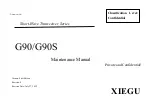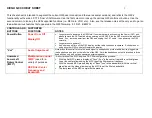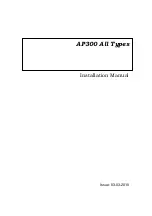
Page
2
of
2
75.0057.09
20070827
7 Company Contact
Do not leave problems unresolved. If a satisfactory solution cannot be achieved after troubleshooting a problem,
please call BEA, Inc. If you must wait for the following workday to call BEA, leave the door inoperable until satisfactory
repairs can be made. Never sacrifi ce the safe operation of the automatic door or gate for an incomplete solution.
The following numbers can be called 24 hours a day, 7 days a week. For more information, visit www.beasensors.com.
US and Canada:
Canada:
Northeast:
1-866-249-7937
1-866-836-1863
1-866-836-1863
Southeast:
Midwest:
West:
1-800-407-4545
1-888-308-8843
1-888-419-2564
6 Programming
HAND HELD CONFIGURATION
PUSH PLATE CONFIGURATION
1. Set 2 dip switches on the receiver to the desired activation cycle
(dip switch 1 - position for toggle (1) or position for pulse (2) and
dip switch 2 - 0.5 second hold (1) or 10 second hold (2).
1. Before beginning, it is easiest to have already
prepared the installation of the pushplate.
2. Press either delay switch or no delay switch on the receiver
depending on the activation requirements (If delay learn is
selected, adjust potentiometer for desire delay time 0-30 seconds).
2. Connect the wires from the transmitter to the NO
and COM contacts of the pushplates switch.
3. Depress transmitter button several times until Blue LED on the
receiver illuminates.
3. Follow Step 1. (Hand-Held Confuguration); depress
the pushplate to activate the transmitter.
4. Test activation by depressing transmitter button. The Blue LED
illuminates when the transmitter is received.
4. Attach the transmitter to the inside of the electrical
box and complete the installation.
NOTE: To erase all codes, press and hold the Learn Button for 10 seconds or until the indicator light goes out.
5 Precautions
Shut off all power going to header before attempting any wiring procedures.
Maintain a clean & safe environment when working in public areas.
Constantly be aware of pedestrian traffi c around the door area.
Always stop pedestrian traffi c through the doorway when performing tests that may result in unexpected reactions by the door.
ESD electrostatic discharge: Circuit boards are vulnerable to damage by electrostatic discharge. Before handling any board
ensure you dissipate your body’s charge.
Always check placement of all wiring before powering up to insure that moving door parts will not catch any wires and cause
damage to equipment.
Ensure compliance with all applicable safety standards (i.e. ANSI A156.10 / 19) upon completion of installation.
DO NOT attempt any internal repair of the sensor. All repairs and/or component replacements must be performed by BEA, Inc.
Unauthorized disassembly or repair:
1. May jeopardize personal safety and may expose one to the risk of electrical shock.
2. May adversely affect the safe and reliable performance of the product will result in a voided product warranty.
4 FCC Compliance
• The Digital Transmitter complies with Part 15 of the FCC rules. Operation is subject to the following two conditions:
1) This device may not cause harmful interference and;
2) This device must accept any interference received including interference that may cause undesired operations.
• This equipment has been tested and found to comply with the limits for a Class B digital device, pursuant to part 15 of the FCC Rules.
These limits are designed to provide a reasonable protection against harmful interference in a residential installation. This equipment
generates, uses and can radiate radio frequency energy and, if not installed and used in accordance with the instruction, may cause
harmful interference to radio communications. However, there is no guarantee that interference will not occur in a particular installation.
If this equipment does cause harmful interference to radio or television reception, which can be determined by turning the equipment off
and on, the user is encouraged to try to correct the interference by one or more of the following measures:
• Reorient or relocate the receiving antenna.
• Increase the separation between the equipment and receiver.
• Connect the equipment into an outlet on a circuit different from that to which the receiver is connected.
• Consult the dealer or an experienced radio/ TV technician for help.
• Changes or modifi cations not expressly approved by BEA, Inc. for compliance could void the user’s authority to operate the equipment.




















